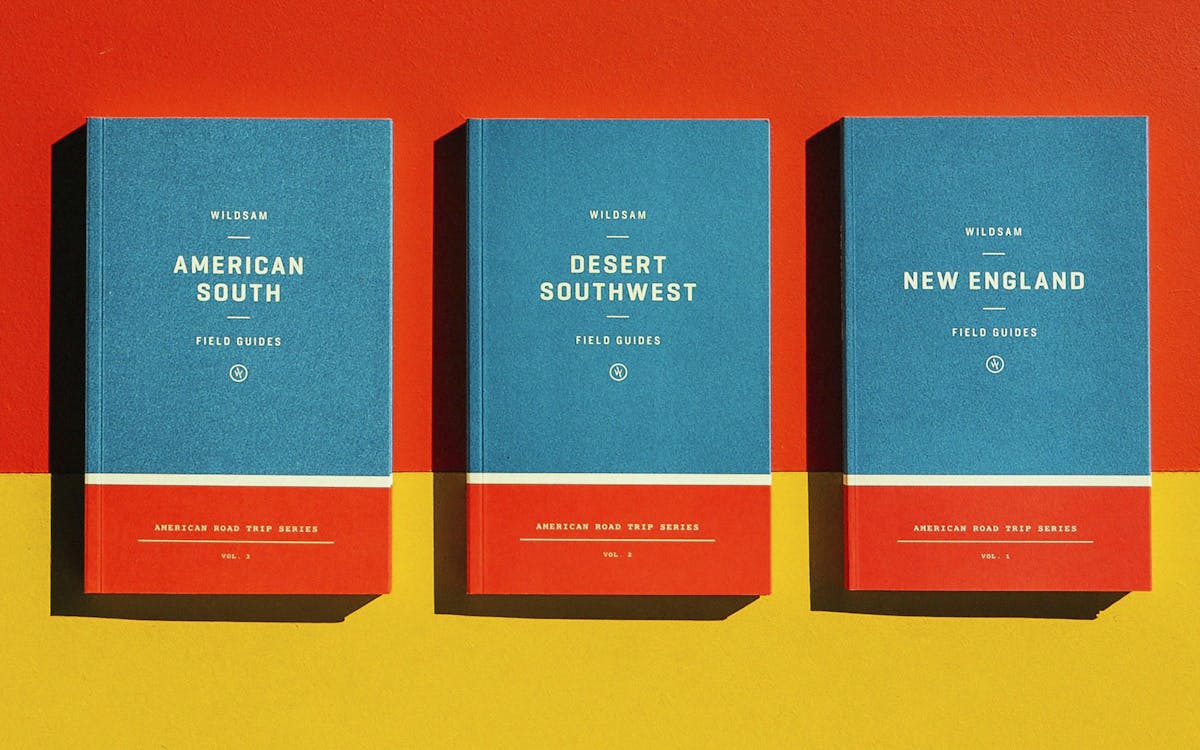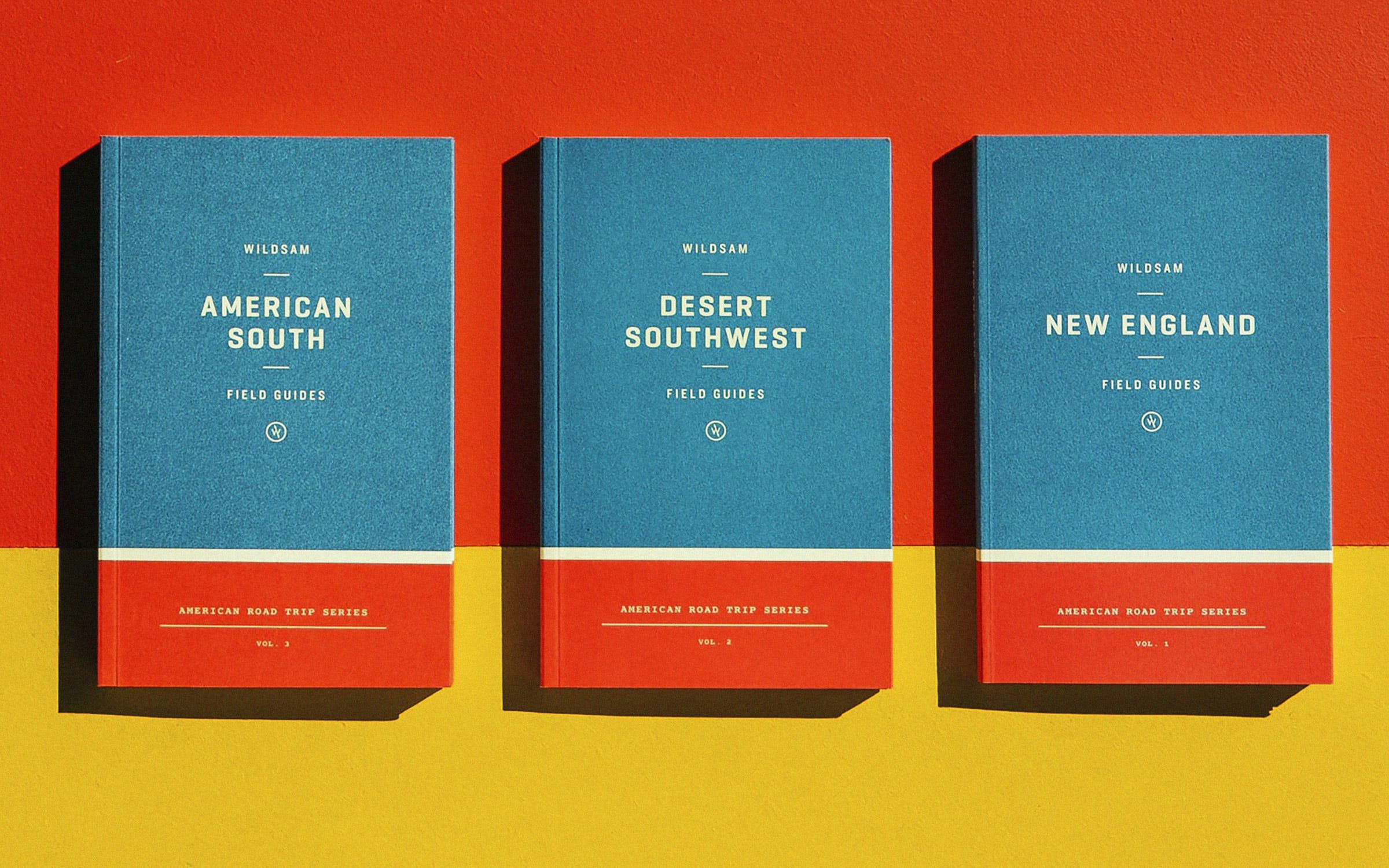
On a recent autumn afternoon, I found myself lost in Big Bend National Park, but not the kind of lost that required directions or a map. Without ever actually setting foot in Big Bend, I got swept away in its endless panoramas and natural wonders as depicted in the latest Wildsam field guide. Leafing through the pages, I took in the spectacular Santa Elena Canyon, with its 1,500-foot rock walls; crossed the Rio Grande River into Boquillas, Mexico; and marveled at roughly 130 million years of fossils on record inside the Lake Flato–designed Fossil Discovery Exhibit. With every page of the travelogue, I came to understand what Lady Bird Johnson—just one of the many famous Texans quoted in the guidebook—meant when she described this place as “the very edge of the world” while hiking the Lost Mine Trail in 1966.
Wildsam field guides are special that way. The Austin-based domestic travel brand has built a reputation for its transportive guides for American cities, national parks, and road trips. Every printed guide has a similar template, and while the books are pocket-size, at just 4 by 6.5 inches, they pack a big punch in an inviting, easily digestible format. Inside, readers will find not just lists highlighting places of interest, but also personal essays, poems, and conversations with locals of note, be they ranchers, firefighters, and wildlife biologists or astronomers, shamans, and pitmasters. A Wildsam guide reads more like an indie zine than it does a Lonely Planet or a Fodor’s, making it an apt fit for a younger generation that seeks to travel like locals, immersing in a destination rather than just checking off a few must-see attractions. The brand is celebrating ten years in business this fall, and founder Taylor Bruce and his team have much to celebrate.
Growing up in LaGrange, Georgia, Bruce didn’t read much aside from Sports Illustrated. It wasn’t until he enrolled in a creative writing class at Vanderbilt University that he experienced his literary awakening. “Writing opened up the world to me in a different way,” Bruce tells me. After graduation, he spent a stint interning at Southern Living, which led to travel-writing positions, freelance work, and an MFA in creative writing from Brooklyn College. Through it all, the seed of Wildsam was beginning to sprout. “I remember sitting in a coffee shop in the West Village [in New York City] and sketching out what a book that’s about a place might look like, the kind of book that I would enjoy. I didn’t even use the word ‘travel guide’ because I wanted to buck against that genre, which felt stale to me, like a phone book,” he said. “I wanted something that would stir emotions or sweep you into a story of a place.”
He started with Nashville, a city that had its own singular spirit and the place that had conjured his creativity years earlier. In the book, he explored the city’s nuances through wide-ranging elements such as illustrated maps of comfort food and music joints and a never-published note by Johnny Cash. “It’s not ‘Let’s go figure out the ten best restaurants.’ We’re trying to answer questions that are more complex, like ‘What makes this place tick?’ ” Bruce said. In the fall of 2012, he pulled from his savings and self-published the Nashville city guide out of his five-hundred-square-foot apartment in New York. To his surprise, the first 2,500 copies sold out within four months.
When Bruce debuted his second book, a field guide to Austin, he had no idea that his wife’s career would soon take him there permanently less than a year later. “I liked the idea of Wildsam being based in Austin. It has that feeling of doing things in an offbeat, carve-your-own-path sort of way,” he said. “It felt like the kind of place that fit Wildsam.”
As the footprint spread, Bruce began attracting attention from companies such as J.Crew and Yeti, as well as contributions from an army of esteemed writers, leaders, and thinkers, from governors to MacArthur fellows. The Wildsam field guide to the moon—one of the brand’s zanier offerings, which was published around the fiftieth anniversary of the lunar landing—includes a story from the Pulitzer Prize–winning novelist Larry McMurtry. Other guides include essays, poems, and interviews with greats such as Wendell Berry, Annette Gordon-Reed, Ron Howard, Cheryl Strayed, and Gay Talese, to name a few.
Along with scoring new material (or digging up archival work) from cultural luminaries, another of Wildsam’s specialties is seeking out the stories of everyday people. While writing the San Francisco city guide, for example, Bruce met a man named Guy Clark who sells fresh flowers on a street corner in the city’s Castro District. The experience of meeting Clark, who lived through the AIDS crisis, still resonates with him today. “Every place has this special stuff buried in the soil. . . . That’s one of the life-giving parts of the job, is if you let people in, you come away a little different every time,” Bruce said.
The forty-ninth book, which came out October 17, is entirely dedicated to Big Bend National Park, with original essays by novelist and screenwriter Peter Behrens and Texas Monthly contributor Sterry Butcher, historical excerpts from Donald Judd, and lessons on local flora and fauna. The stories of river guides, silversmiths, and native-plant experts are woven into the book, along with those of visitors who came to love this land, including the Austrian American writer and illustrator Ludwig Bemelmans, who is best known for creating the Madeline picture books. “In a lifetime spent traveling, here I came upon the greatest wonder,” Bemelmans writes of Big Bend. “The mantle of God touches you; it is what Beethoven reached for in music; it is panorama without beginning or end. . . . No words can tell you, and no painter hold it. It is only to be visited and looked at with awe. It will make you breathe deeply whenever you think of it, for you have inhaled eternity.”
In 2019, a group led by Michael Lynton, the former CEO of Penguin Group and the current chairman of Snap (the parent company of Snapchat), made an investment in the company, which enabled Bruce to hire a team of four editors. Since then, Wildsam has grown from fifteen books to fifty. Today it takes six months to complete a new field guide. The process begins with a kickoff meeting, followed by a four-day trip to the destination for the assigned editor. “They should come away from that having met a bunch of people, the snow globe kind of shook, and then we build a book map,” said Bruce. Meanwhile, a local team of editors, writers, artists, and cultural experts is compiled on-site. “That’s the only way these things have the kind of gritty, earned thinking.”
During the COVID-19 pandemic, Wildsam’s direct-to-consumer online sales rose by 500 percent. “[With our] series about national parks and road trips, we were positioned to be relevant,” Bruce said. It’s an impressive feat for a company that has to compete with the likes of online guides, travel bloggers, and Tripadvisor, and whose books don’t contain any photographs, a bold decision that sets Wildsam guides apart. This May, Wildsam was acquired by Camping World, a recreational vehicle company. “They were really interested in figuring out a way to work together, because they have this incredible network of travelers that take road trips across the country, and they want to be a source of inspiration and storytelling to those people,” Bruce explained. “The more we talked, the more I was convinced.” In its new chapter, the brand will expand to include podcasts, newsletters, and film projects.
As the company’s rapid growth attests, Wildsam is, at its core, selling more than cleverly designed travel guides to American cities and places. It’s stoking the dwindling fire of American adventure, one embodied in the character Sam Hamilton from John Steinbeck’s East of Eden, for whom Wildsam is named. The “faraway joyous look” with which Sam decides to face the unknown encompasses Wildsam’s foundational spirit. Though the guides don’t delve into politics, they do explore history and policy, along with moments of wonder and joy. “In the last ten years, it does feel like the experience of being an American has gotten flipped upside down one hundred times,” Bruce said. “Even through the mess and hectic news cycles, at the end of the day our view is that the world is good, and our books set out to prove that.”








